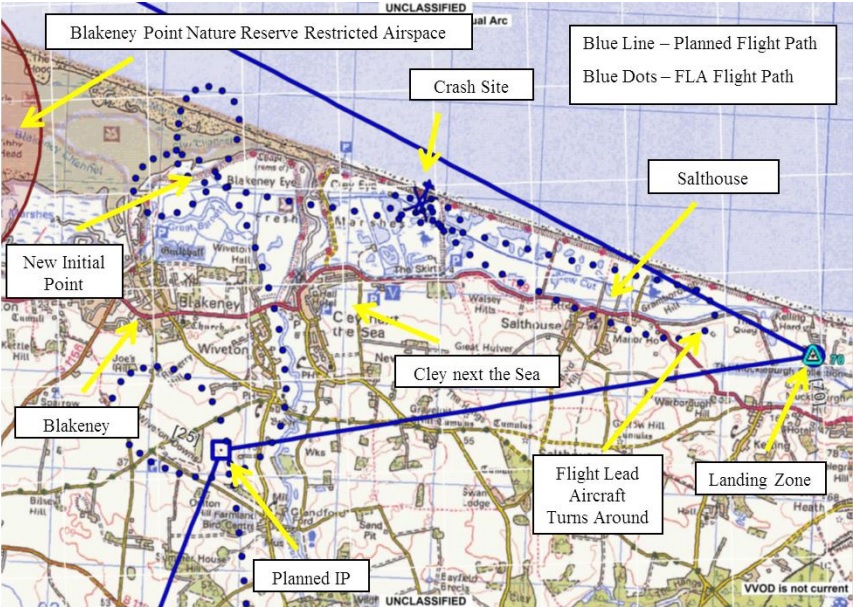USAF HH-60G Downed by Geese in Norfolk During CSAR Training: Bird Stike, 7 January 2014
After dark on 7 January 2014, US Air Force (USAF) Sikorsky HH-60G Pave Hawk 88-26109, of the 56th Rescue Squadron, at RAF Lakenheath, Suffolk, crashed in marshland near the village of Cley next the Sea, Norfolk, UK. The four crew were fatally injured. The aircraft, valued at $40.3 million was destroyed.

USAF Sikorsky HH-60G Pace Hawk 88-26109 at the American Air Day at Duxford in 2010 (Credit:Tim Felce (Airwolfhound) CC BY-SA 2.0)
The helicopter had experienced multiple bird strikes during a nighttime rescue of a simulated downed F-16 pilot as a check ride for 88-26109’s pilot.
The Combat SAR training mission involved two HH-60Gs, a lead aircraft and the accident aircraft. Both crews were using night vision goggles. The aircraft departed RAF Lakenheath at 1733 Local Time. At 1804 88-26109 was flying east toward the Landing Zone (LZ) near Salthouse, behind and the the left of the lead aircraft, separated by about 0.3nm / 10 seconds, at approximately 110 KIAS and 110 feet above ground level. The 56th Rescue Squadron frequently used this LZ for similar training missions. The flight path went over the over the Norfolk Wildlife Trust’s Cley Marshes, a bird sanctuary established in 1926.
This was not part of the original plan, but strong winds and a desire to avoid noise disturbance in the village of Blakeney, meant that in-flight the ‘initial point’, where the aircraft would orbit before the run in to the LZ, was shifted toward the marshes.
A flock of geese, likely startled by the noise of the oncoming helicopters, took flight from Cley Marshes and struck the 88-26109. At least three geese penetrated the windscreen. These rendering the pilot and co-pilot unconscious. One hit the aerial gunner rendering him unconscious too. At least one goose hit the nose of the aircraft, disabling the Trim and Flight Path Stabilization systems.
The types of geese involved weighed between 6 and 12 lb (2.7-5.4 kg). These are substantially above any rotorcraft certification requirement. The AIB don’t discuss the design and certification requirements of the H-60. According to a Swedish accident report the UH-60M Black Hawk can withstand a 1.8 kg bird at maximum speed up to c5,000ft. Part 29, for civil rotorcraft over 3,175 kg has a 1 kg bird strike requirement at maximum speed up to 8,000ft.
This damage and injury resulted in a loss of control and the helicopter rolled left and it impacted the ground approximately three seconds after being struck by the birds. The lead aircraft returned and landed alongside.

Accident Site: USAF Sikorsky HH-60G Pace Hawk 88-26109 at Cley next the Sea, Norfolk (Credit: AIB Annotation of NPAS Image, via USAF)
The UK Military Low Flying Handbook, available to the crews, states crews should cross coastlines at right angles and above 500 feet AGL to avoid bird strikes in this low flying area, but the AIB note this advice “did not support mission requirements”.
The January 2014 UK MOD bird activity map indicated an area of low-bird activity over Cley Marshes. However, on 6 January 2014), the NWT counted a flock of approximately 400 various geese, along with other birds at Cley Marshes. A storm surge that affected the near-by National Trust Blakeney Nature Reserve in early December 2013 is believe to have caused several flocks of birds to relocate in the direction of Cley Marshes. The parent 48th Fighter Wing safety briefing for January 2014 instructed aircrew to assume a moderate en route bird risk (though one might argue that the final approach to a LZ would normally be ranked higher but for the very low en-route operating height), which these crews did. The crew’s pre-flight overall Operational Risk Management (ORM) rating for this flight was ‘Low’.
Safety Resources
We have previously written:
- Safety Lessons from a Fatal Helicopter Bird Strike: A fatal accident occurred on 4 Jan 2009 involving Sikorsky S-76C++ N748P of PHI that highlighted a range safety lessons. We also discuss current activity on enhancing bird strike requirements.
- Swedish Military NOE Helicopter Bird Strike: During a low-level night two-ship training flight a Swedish Armed Forces Agusta 109LUH collided with a large bird.
- Power of Prediction: Foresight and Flocking Birds looks at how a double engine loss due to striking Canada Geese had been predicted 8 years before the US Airways Flight 1549 ditching in the Hudson (which was just days after the Louisiana helicopter accident).
- NTSB Recommendations on JT15D Failure to Meet Certification Bird Strike Requirements
- Final Report Issued on 2008 Bird Strike Accident in Rome
- BFU Investigate S-76B Descending to 20ft at 40 kts En Route in Poor Visibility
- UPDATE 28 March 2019: USAF T-38C Downed by Bird Strike
- UPDATE 30 March 2019: Contaminated Oxygen on ‘Air Force One’ Poor standards at a Boeing maintenance facility resulted in contamination of two oxygen systems on a USAF Presidential VC-25 (B747).
- UPDATE 30 October 2019: ‘Crazy’ KC-10 Boom Loss: Informal Maintenance Shift Handovers and Skipped Tasks
- UPDATE 11 May 2020: European Search and Rescue (SAR) Competition Bonanza
- UPDATE 7 November 2020: Deadly Dusk Air Ambulance Bird Strike
- UPDATE 30 December 2020: AS350B3/H125 Bird Strike with Red Kite
- UPDATE 23 March 2022: Big Bustard Busts Blade: Propeller Blade Failure After Bird Strike
- UPDATE 28 May 2022 AW169 Birdstrike with a Turkey Vulture
- UPDATE 17 February 2023: Dusk Duck: Birdstrike During Air Ambulance Flight
About 8% US military of all Class A, B and C aviation mishaps from fiscal 2011 through 2017 resulted from wildlife strikes, according to data obtained by Military Times.
FAA report 665 helicopter bird strikes over the last 3 years
UPDATE 19 April 2021: EASA have issued Safety Information Bulletin SIB 2021-07 on Bird Strike Risk Mitigation in Rotorcraft Operations and accompanying safety promotion material.


Recent Comments